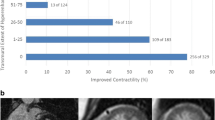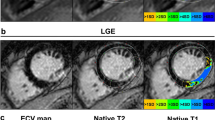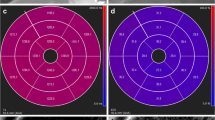Abstract
Cardiovascular MRI has effectively become a reference standard for quantifying ventricular volumes and function and for measuring the myocardial scar burden after myocardial infarction. Imaging of late gadolinium enhancement and microvascular obstruction carries strong prognostic information for identifying patients who would benefit from anti-remodeling therapy. The combination of gadolinium enhancement, perfusion, and cine imaging should make MRI the modality of choice in the assessment of left ventricular dysfunction and remodeling. The use of MRI in clinical trials of heart failure could help reduce sample size requirements because of its accuracy and reproducibility. This review describes the use of MRI in assessing ventricular remodeling and viability and summarizes the few studies that have relied on MRI for image-based markers of ventricular remodeling.
Similar content being viewed by others
References and Recommended Reading
Pelliccia A: Athlete’s heart and hypertrophic cardiomyopathy. Curr Cardiol Rep 2000, 2:166–171.
Pfeffer MA, Braunwald E: Ventricular remodeling after myocardial infarction. Experimental observations and clinical implications. Circulation 1990, 81:1161–1172.
Cohn JN, Ferrari R, Sharpe N: Cardiac remodeling—concepts and clinical implications: a consensus paper from an international forum on cardiac remodeling. J Am Coll Cardiol 2000, 35:569–582.
Kim RJ, Wu E, Rafael A, et al.: The use of contrast-enhanced magnetic resonance imaging to identify reversible myocardial dysfunction. N Engl J Med 2000, 343:1445–1453.
Friedrich J, Apstein CS, Ingwall JS: 31P nuclear magnetic resonance spectroscopic imaging of regions of remodeled myocardium in the infarcted rat heart. Circulation 1995, 92:3527–3538.
Neubauer S: Cardiac magnetic resonance spectroscopy: potential clinical applications. Herz 2000, 25:452–460.
Zhang J, Wilke N, Wang Y, et al.: Functional and bioenergetic consequences of postinfarction left ventricular remodeling in a new porcine model. MRI and 31 P-MRS study. Circulation 1996, 94:1089–1100.
Francois CJ, Fieno DS, Shors SM, Fin JP: Left ventricular mass: manual and automatic segmentation of true FISP and FLASH cine MR images in dogs and pigs. Radiology 2004, 230:389–395.
Stillman AE, Wilke N, Jerosch-Herold M: Use of an intravascular T1 contrast agent to improve MR cine myocardial-blood pool definition in man. J Magn Reson Imaging 1997, 7:765–767.
Pennell DJ, Underwood SR, Longmore DB: Improved cine MR imaging of left ventricular wall motion with gadopentetate dimeglumine. J Magn Reson Imaging 1993, 3:13–19.
Rehr RB, Malloy CR, Filipchuk NG, Peshock RM: Left ventricular volumes measured by MR imaging. Radiology 1985, 156:717–719.
Shors SM, Cotts WG, Pavlovic-Surjancev B, et al.: Heart failure: evaluation of cardiopulmonary transit times with time-resolved MR angiography. Radiology 2003, 229:743–748.
Debatin JF, Nadel SN, Paolini JF, et al.: Cardiac ejection fraction: phantom study comparing cine MR imaging, radionuclide blood pool imaging, and ventriculography. J Magn Reson Imaging 1992, 2:135–142.
Sechtem U, Pflugfelder PW, Gould RG, et al.: Measurement of right and left ventricular volumes in healthy individuals with cine MR imaging. Radiology 1987, 163:97–702.
Grothues F, Smith GC, Moon JC, et al.: Comparison of interstudy reproducibility of cardiovascular magnetic resonance with two-dimensional echocardiography in normal subjects and in patients with heart failure or left ventricular hypertrophy. Am J Cardiol 2002, 90:29–34.
Bellenger NG, Davies LC, Francis JM, et al.: Reduction in sample size for studies of remodeling in heart failure by the use of cardiovascular magnetic resonance. J Cardiovasc Magn Reson 2000, 2:271–278.
Groenning BA, Nilsson JC, Sondergaard L, et al.: Antiremodeling effects on the left ventricle during beta-blockade with metoprolol in the treatment of chronic heart failure. J Am Coll Cardiol 2000, 36:2072–2080.
Kono T, Sabbah HN, Rosman H, et al.: Left ventricular shape is the primary determinant of functional mitral regurgitation in heart failure. J Am Coll Cardiol 1992, 20:1594–1598.
Lamas GA, Vaughan DE, Parisi AF, Pfeffer MA: Effects of left ventricular shape and captopril therapy on exercise capacity after anterior wall acute myocardial infarction. Am J Cardiol 1989, 63:11 7–1173.
Mann DL: Left ventricular size and shape: determinants of mechanical signal transduction pathways. Heart Fail Rev 2005, 10:95–100.
Balzer P, Furber A, Delepine S, et al.: Regional assessment of wall curvature and wall stress in left ventricle with magnetic resonance imaging. Am J Physiol 1999, 277:H901–H910.
DeAnda A Jr, Komeda M, Moon MR, et al.: Estimation of regional left ventricular wall stresses in intact canine hearts. Am J Physiol 1998, 275:H1879–H1885.
Grossman W, Braunwald E, Mann T, et al.: Contractile state of the left ventricle in man as evaluated from endsystolic pressure-volume relations. Circulation 1977, 56:845–852.
Wollmuth JR, Bree DR, Cupps BP, et al.: Left ventricular wall stress in patients with severe aortic insufficiency with finite element analysis. Ann Thorac Surg 2006, 82:840–846.
Blom AS, Mukherjee R, Pilla JJ, et al.: Cardiac support device modifies left ventricular geometry and myocardial structure after myocardial infarction. Circulation 2005, 112:1274–1283.
Lund GK, Stork A, Muellerleile K, et al.: Prediction of left ventricular remodeling and analysis of infarct resorption in patients with reperfused myocardial infarcts by using contrast-enhanced MR imaging. Radiology 2007, 245:95–102.
Judd RM, Lugo-Olivieri CH, Arai M, et al.: Physiological basis of myocardial contrast enhancement in fast magnetic resonance images of 2-day-old reperfused canine infarcts. Circulation 1995, 92:1902–1910.
Fieno DS, Hillenbrand HB, Rehwald WG, et al.: Infarct resorption, compensatory hypertrophy, and differing patterns of ventricular remodeling following myocardial infarctions of varying size. J Am Coll Cardiol 2004, 43:2124–2131.
Bello D, Shah DJ, Farah GM, et al.: Gadolinium cardiovascular magnetic resonance predicts reversible myocardial dysfunction and remodeling in patients with heart failure undergoing beta-blocker therapy. Circulation 2003, 108:1945–1953.
Orn S, Manhenke C, Anand IS, et al.: Effect of left ventricular scar size, location, and transmurality on left ventricular remodeling with healed myocardial infarction. Am J Cardiol 2007, 99:1109–1114.
Kwong RY, Chan AK, Brown KA, et al.: Impact of unrecognized myocardial scar detected by cardiac magnetic resonance imaging on event-free survival in patients presenting with signs or symptoms of coronary artery disease. Circulation 2006, 113:2733–2743. [Published erratum appears in Circulation 2006, 114:e365.]
Kitagawa K, Sakuma H, Hirano T, et al.: Acute myocardial infarction: myocardial viability assessment in patients early thereafter: comparison of contrast-enhanced MR imaging with resting (201)Tl SPECT. Single photon emission computed tomography. Radiology 2003, 226:138–144.
Mahrholdt H, Wagner A, Holly TA, et al.: Reproducibility of chronic infarct size measurement by contrast-enhanced magnetic resonance imaging. Circulation 2002, 106:2322–2327.
Thiele H, Kappl MJ, Conradi S, et al.: Reproducibility of chronic and acute infarct size measurement by delayed enhancement-magnetic resonance imaging. J Am Coll Cardiol 2006, 47:1641–1645.
Wu KC, Zerhouni EA, Judd RM, et al.: Prognostic significance of microvascular obstruction by magnetic resonance imaging in patients with acute myocardial infarction. Circulation 1998, 97:765–772.
Baks T, van Geuns RJ, Biagini E, et al.: Effects of primary angioplasty for acute myocardial infarction on early and late infarct size and left ventricular wall characteristics. J Am Coll Cardiol 2006, 47:40–44.
Nazarian S, Roguin A, Zviman MM, et al.: Clinical utility and safety of a protocol for noncardiac and cardiac magnetic resonance imaging of patients with permanent pacemakers and implantable-cardioverter defibrillators at 1.5 tesla. Circulation 2006, 114:1277–1284.
Brodoefel H, Klumpp B, Reimann A, et al.: Late myocardial enhancement assessed by 64-MSCT in reperfused porcine myocardial infarction: diagnostic accuracy of low-dose CT protocols in comparison with magnetic resonance imaging. Eur Radiol 2007, 17:475–483.
Author information
Authors and Affiliations
Corresponding author
Rights and permissions
About this article
Cite this article
Jerosch-Herold, M., Kwong, R.Y. Magnetic resonance imaging in the assessment of ventricular remodeling and viability. Curr Heart Fail Rep 5, 5–10 (2008). https://doi.org/10.1007/s11897-008-0002-4
Published:
Issue Date:
DOI: https://doi.org/10.1007/s11897-008-0002-4




